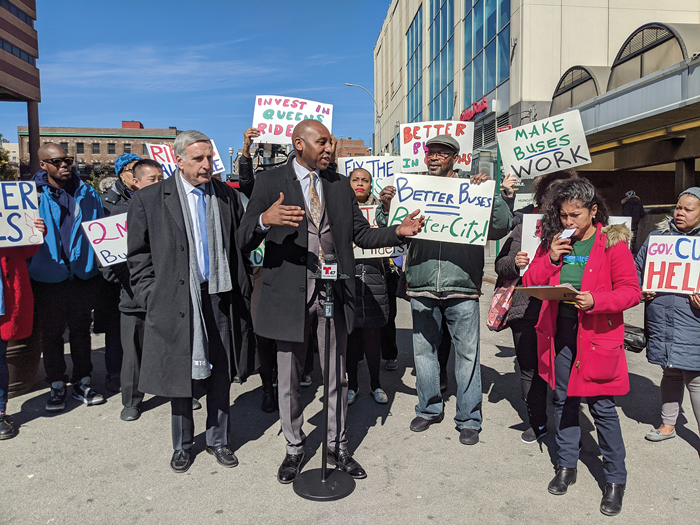Photo Courtesy of Riders Alliance
City Councilman, and Queens borough president candidate, Donovan Richards (D-Laurelton) delivers remarks on Thursday during a rally for a better borough bus network at the Q5 bus stop, Parsons Boulevard and Archer Avenue in Jamaica.
By Michael V. Cusenza
A coalition of three top transit advocacy groups on Thursday announced a platform of borough bus riders demands developed from riders’ concerns about the Metropolitan Transportation Authority’s draft Queens bus network redesigns.
Why has the MTA decided to redesign the massive Queens system? According to MTA New York City Transit officials, the borough’s bus network “has not substantially changed to meet the evolving needs of customers. We’ve made minor changes to pieces of the network, but have not kept pace with growth in Queens. Our customers asked us to take a fresh look at how we can redesign the Queens Bus Network to provide more reliable service, shorter travel times, and better connections. Nearly 52 percent of Queens residents rely on public transit for their daily commutes, and at least 11 percent commute primarily by bus. So, it is imperative that we reinvent the borough’s bus network to better serve its residents and workers, so they can spend less time and energy commuting.”
On Thursday, representatives from the Riders Alliance, Straphangers Campaign, and the Tri-State Transportation Campaign presented a list of seven principles to help guide the MTA’s revision process as the agency finalizes its plan: invest in the bus network; equitable service; increased frequency; optimizing routes; improving stop amenities; better connections; and better communication with riders.
Some of the myriad recommendations include:
Gov. Andrew Cuomo should invest in transit options that are adjacent to the bus, which when coupled together will help unlock the city for riders in Queens. Such programs could include additional LIRR discounts for rides within NYC.
The MTA should provide additional service to low-income neighborhoods in Queens. According to the U.S. Department of Housing and Urban Development, a four-person household is considered low-income if they make an average salary of $31,300. The MTA should prioritize service improvements for low- income neighborhoods in Queens, including Far Rockaway, Rockaway Beach, Flushing, Ridgewood, Corona, Jamaica, East Elmhurst, Elmhurst, Jackson Heights, Murray Hill, Hillcrest, Jamaica Hills, Rego Park;
The MTA should maintain or add routes that serve job centers, prioritizing sites with high numbers of hourly workers like both airports, malls, hospitals, senior centers, and universities;
The MTA should increase frequency on bus routes that serve over 10,000 daily bus riders to 10 minutes or better during the day (5 a.m.—11 p.m.);
The MTA should increase frequency on buses that operate overnight to frequencies of 20 minutes or better (11 p.m.—5 a.m.);
The MTA should operate buses 24/7 to both airports.
Add more direct North to South buses to connect Southeast Queens with Northeast Queens
Add more local bus routes that connect into Manhattan, express bus routes should not be the only option because its high cost can be a barrier to many;
Subway deserts in Northeast and Southeast Queens should have access to frequent service beyond the rush hour timeframe.
“We’re calling on the MTA to ensure that rider needs are met in its final redesign plan, and on Albany to guarantee that the MTA has the funding it needs to make this plan a success,” said Straphangers Campaign Director Jaqi Cohen.

